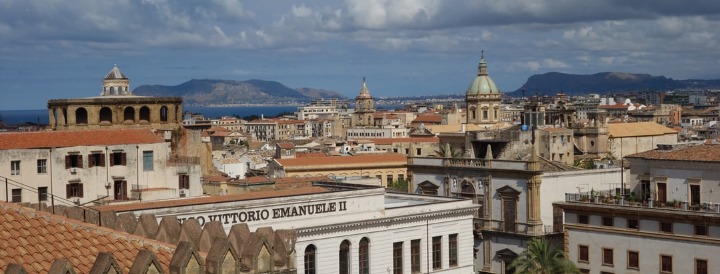In its own wide bay underneath the limestone bulk of Monte Pellegrino, and fronting the broad, fertile Conca d’Oro (Golden Shell) Valley, PALERMO is stupendously sited. Originally a Phoenician, then a Carthaginian colony, this remarkable city was long considered a prize worth capturing. Named Panormus (All Harbour), it’s mercantile attractions were obvious, and under Saracen and Norman rule in the ninth to twelfth centuries, Palermo became the greatest city in Europe – famed for the wealth of its court, and peerless as a center of learning. There are plenty of relics from this era, but it’s the rebuilding of the sixteenth and seventeenth centuries that shaped the city as you see it today.
It’s worth making Palermo your first stop in Sicily. It’s the island’s main transport center, and it boasts Sicily’s greatest concentration of sights. Quite apart from the Arab influence in its finest churches, there’s more than a hint of the city’s eastern past in its undisciplined centre, a sprawling, almost anarchic mass with no real focus: great pockets of medieval alleys, nineteenth-century piazzas, twentieth-century bombsites, and contemporary office blocks all conspire to confuse what is essentially a straightforward street grid. Money from Rome and from the European Union has been earmarked for a redevelopment of the city center, and, despite signs of improvement, the obstacles remain huge: this is partly due to the age-old system of kickbacks for contracts and tenders to bent politicians and the Mafia, which have creamed off much of the money. One of the few to stand up against this state of affairs has been Leoluca Orlando , who, following his deposition by his own Christian Democrat party in 1990, went on to found and lead the anti-Mafia and anti-Masonic party, La Rete , and he continues to make progress against the forces of graft and corruption as Palermo’s mayor. While doubtless retaining his place on the Mafia’s hit list, Orlando’s prominence on the national stage has helped to focus attention on reform of the city’s institutions and reverse the tendency of neglect and decay that has characterized the city for centuries.
The essential sights are all pretty central, and if you are disciplined enough you could get around them in a couple of days. Paramount are the hybrid Cattedrale and nearby Palazzo dei Normanni (Royal Palace), with its superb, mosaic-decorated chapel, the Cappella Palatina ; the glorious Norman churches of La Martorana and San Giovanni degli Eremeti ; the Baroque opulence of San Giuseppe dei Teatini and Santa Caterina ; and three magnificent museums – inspiring collections of art, archeology and ethnography.
This historical jumble of treasures has its downside. Many people have continued to live in their medieval ghettos, unemployment is endemic, the old port largely idle and petty crime commonplace. Some areas – La Kalsa and area around La Cala in particular – can be positively dangerous if you’re not careful, and every pensione owner will warn you to watch your money and camera. Don’t be paranoid, though: things are not significantly worse than any other European city, and the only rule is to avoid any quiet neighborhood, especially at night.
Nightlife in Palermo
The strangest thing about Palermo’s fast lifestyle is that it virtually stops at around 8 pm. Apart from perfunctory passeggiata between the Teatro Massimo and Piazza Castelnuovo, in most areas, everything is quiet outside after dark. In summer, most young people head for Mondello, and buses run there and back all night. Still, for an outdoor, early-evening drink , Via Principe di Belmonte is a good spot – closed to traffic, and with several popular places – for coffees and beers. Evening crowds also congregate at the nearby Bottiglieria del Mássimo , a wine bar with pavement seating at Via Spinuzza 59, and, at the bottom of this street, in the bars on Piazza Olivella, opposite the archeological museum; all of these remain open until late. For a refreshing non-alcoholic drink on the hoof, the stand-up Pinguino at Via Ruggero Séttimo 86 serves famous milkshakes and a range of non-alcoholic cocktails and also has excellent ice cream (closed Mon).
If its discos and video bars you’re after, what exists is all in the new, northern section of the city, along Viale Strasburgo, or along Via Generale Arimondi (beyond the Giardino Inglese). Otherwise, there are cinemas on Via Cavour and Via E. Amari, and, on Mondays (winter only), English-language films at the Fiamma Cinema, Largo Abeti 3, on the corner of Via Libertŕ and Via Notarbártolo (tel 091.625.1868).
